[fusion_builder_container hundred_percent=”yes” overflow=”visible”][fusion_builder_row][fusion_builder_column type=”1_1″ background_position=”left top” background_color=”” border_size=”” border_color=”” border_style=”solid” spacing=”yes” background_image=”” background_repeat=”no-repeat” padding=”” margin_top=”0px” margin_bottom=”0px” class=”” id=”” animation_type=”” animation_speed=”0.3″ animation_direction=”left” hide_on_mobile=”no” center_content=”no” min_height=”none”]
I am an animal person. Always have been. And not in a needy-gotta-take-care-of-something sort of way (although I do love it when I get to bottle feed a rescue), but in a wow-what-an-interesting-critter sort of way. I only have a handful of ‘regular’ animals- two dogs and two cats. My love lies in the unusual types of animals, and I bring this love into my classroom.
I’m of the belief that kids can learn a lot by taking care of another species. And you can learn a lot about the kids by observing how they do this. And in my classroom I’m all about providing experiences that kids possibly wouldn’t get elsewhere.
To date, we have a hedgehog, two adult bearded dragons (which we got as hatchlings and the kids got to watch them grow), a tank of freshwater fish, a ball python, a chameleon, a rabbit who roams freely around the classroom (the kids participated in his litter training), two fire belly frogs, six student-gathered toads (started out with three, but the kids kept finding them so we kept adding to the tank), a sugar glider, Humphrey the hamster who goes home with a student each weekend (awesome books by Betty Birney), and a micro pot-bellied pig who travels back and forth with me each day. Not to mention the gecko that will be joining our menagerie this weekend due to a grant from PetSmart (but, shhhhh… it’s a surprise for my students)
Yep. It’s a zoo. Or maybe a farm? I’m not sure of the classification anymore, with the exception that the kids LOVE it. Most parents love it too, simply because they aren’t the ones having to take care of the animals! And no, we have the animal smell under control and yes, everything that needs vaccinations has had them, and yes, I do extensive research about every animal before I get it, and no, the animals are not harmed, and yes, the kids are taught how to handle and treat them before they are let loose with them. Have I covered all the questions?
Now let me explain what we do with these animals. They aren’t just to look at, but to interact with. And when I say that I mean right down to changing cages, feeding and watering and providing the attention that they need. These animals are read to, loved on, told secrets that no one else knows, cried to, written about, drawn about, journaled about and most importantly, LEARNED about. And I’m not just talking science.
I teach life principles in my class, because let’s face it, in the digital, selfish, materialistic, busy, over-tested, education-stripped time in which we teach life principles have fallen by the wayside. Communicating at dinner with the entire family present and polite is not the norm. Socializing in pretend play has almost disappeared from our early childhood classrooms. Respecting parents who are meeting themselves coming and going has been replaced with the blame game and guilt trips. So thankfully in my little bubble of a school, I have the ability to continue teaching the Beaver Cleaver method of please, thank you, excuse me, sit-down-while-you-eat, don’t-talk-with-your-mouth-full, yes ma’am, yessir, no-thank-you and please-may-I in addition to responsibility, perseverance, patience, good sportsmanship, patriotism, cooperation and a slew of other stone-age character traits.
And I use the animals to teach about most of them.
Animals don’t judge. Animals don’t make fun of others, Animals don’t tell kids they are below level, or not good enough. Animals don’t harbor ill feelings (unless you pull tails or ears, and that’s a whole lesson in itself). Animals don’t stress kids out with tests. Animals are totally unconditional and will listen and be willing participants in tea parties, journal writing and reluctant reader book nook reading. Animals also teach how important it is to care for another living thing. And let’s face it, isn’t that a huge part of life? I want to educate my students, not just teach them.
There is a huge difference between the two.
(If your school allows animals in the classroom, be sure to google ‘animals in the classroom’ grants. There are many pet stores that will provide grants for classroom pets, with very little or no cost out of the teacher’s pocket.)[/fusion_builder_column][/fusion_builder_row][/fusion_builder_container]




